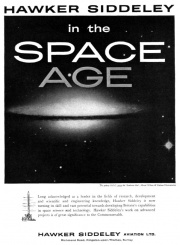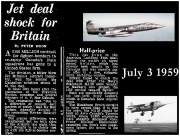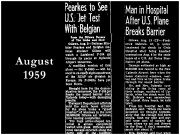The Empire Strikes Out - Canada's Defence & The Commonwealth Space Program - Part 4 by Robert Godwin
From The Space Library
Just two weeks after the announcement of the joint US/Canadian satellite venture, and ignoring the recommendations of the team at Hatfield, the British government decided to hedge their bets. Before they would consider an all-British space program they would test British experiments using rented space on American Atlas and Thor missiles; in essence following Canada's lead.38
About a month later, on June 13th 1959, the United States Congress began talking about cutbacks to the Bomarc missile program. Just two days after that James Floyd, the genius engineer who had built the first civilian jet airliner in North America and whose career had spanned everything from the legendary Lancaster bomber, to the CF-100 fighter, to the Avro Arrow, decided to return to England. Where he took up the role of Chief Engineer at the Hawker Siddeley Advanced Projects Office.
Two weeks later on June 29th the British Prime Minister Harold MacMillan formally announced the desire of his government to launch a Commonwealth Space Program. The pundits assumed that Canada would, and should, play a major role.39
Meanwhile, Crawford Gordon, the tempestuous head of A.V. Roe Canada had resigned. His relationship with Diefenbaker was known to be somewhat less than cordial so his departure was expected to clear the way for a new start at the troubled company; particularly since the government in Ottawa was still faced with the same unresolved problem that it had faced almost a decade earlier - what to do with Canada's Air Force. The CF-100 and the F-86 Sabres on-station were obsolete and no match for the latest generation of Soviet fighters. Several choices were considered by the cabinet: buy the new Mirage from France; purchase an experimental aircraft from Lockheed; or allow A.V. Roe to build its parent company's own brand-new experimental Hawker 1127. On July 3rd the interested parties were told that the government had chosen the Lockheed deal despite not having conducted a single test flight of the aircraft.
The parliamentary opposition accused the government of buying an untested aircraft which didn't meet Canada's requirements. The highly modified Lockheed F-104G fighter—customised to be all things to all services—would never live up to any reasonable expectations. It became known as the Widowmaker, killing pilots at an alarming pace over the next four years; with an accident rate over seven times the average across the service.40 41
The Lockheed Starfighter (its real name) was also almost useless for patrolling the vast expanse of Canada's north. It was fast but it didn't have the range or the armaments for the job. The reason cited for the purchase of this particular aircraft was to fulfill Canada's obligation to NATO and to protect the very same European countries that had regularly been buying Avro aircraft to defend themselves. The last batch of CF-100s had only arrived in Belgium two years earlier.42
The NATO issue had been discussed in secret cabinet meetings back in February but was dismissed at the time as not being relevant since the government hadn’t yet committed to rearming the Canadian Air Division in Europe; a task which was known would cost at least $500M and would do nothing for defending the "homeland." The two proposed Bomarc squadrons would cost Canada $20M but would only barely protect parts of Ontario and Quebec and would be subject to American control because they would be equipped with nuclear warheads. Around the time of the cancellation of the Arrow, Avro had quoted that the full complement of 137 Arrows would cost about $375M, considerably less than the price being told by the government to the Canadian media.43 It was later asserted that the Arrow couldn't have operated in NATO because it was specifically integrated into the NORAD SAGE automated radar control system. However, unlike BOMARC, the Arrow was fully capable of operating independently of the SAGE system, and despite the F-104 being completely incapable of using SAGE, two dozen F-104Gs were purchased for use in Canada in complete contradiction of this assertion.44
On August 13th, a month after the decision to buy the F-104G, Lockheed finally demonstrated the aircraft Pearkes had purchased. A standard version of the plane was brought to Ottawa to be put through its paces. In a moment of almost perverse irony the pilot went supersonic at low level blasting out windows at the brand new Ottawa airport terminal, producing $100,000 damage. The shock wave even sent some local residents to hospital with concussion.45
Five days later, under license from Lockheed, the government gave the new fighter contract to Canadair. The line of reasoning being that since Canadair didn’t do any work for its parent company it was, in all but title, a Canadian company. Assuming that this was a reasonable argument for having left A.V. Roe out in the cold, it didn’t make allowances for the fact that Canadair already had a robust stack of orders on its plate, including the Bomarc and the Black Brant, and didn't have the tooling necessary for the job.46 Canadair would have to purchase new equipment; similar to the world-class machinery that was now lying fallow at Avro.
Part of the reason the Mirage deal had been rejected was because it was known that France wanted to equip the aircraft with the Iroquois engine, this would have by implication meant that part of the contract would go to Avro, but the Iroquois had already been destroyed, so this option was politically suicidal.47 Instead the government allowed Avro to build an inferior General Electric engine for the F-104s, effectively saving a quarter of the jobs recently lost.
Go to Chapter
Footnotes
38Daily Express May 4 1959
39Toronto Star Jun 29 1959
40Globe and Mail Oct 3 1963
41Toronto Star Aug 21 1976
42Aircraft Sep 1957
43Canadian Aviation & The Avro Arrow – Fred Smye - Createspace 2014
44Minutes of Cabinet Defence Committee Feb 10th 1959
45Globe and Mail Aug 14 1959
46Flight magazine Aug 28 1959
47Toronto Star May 21 1959



